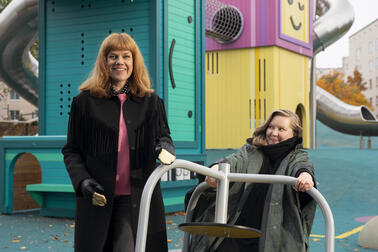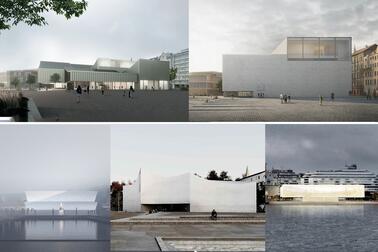
How do cities benefit from design and how does design help solve the challenges of the future? These topics were discussed on 6 September at Helsinki City Hall’s event square in the “Design and the City: Learnings from a 10-Year Journey” seminar.
The seminar marked Helsinki’s 10-year design journey. In 2012, Helsinki was the World Design Capital together with the cities of Espoo, Vantaa, Kauniainen and Lahti. The year marked the launch of the extensive use of design throughout Helsinki’s city organisation.
“The design capital year highlighted the benefits of design thinking in improving cities and services. The volume of design activities in Helsinki has greatly increased in the last ten years and design is part of the city’s core functions and city strategy. Now is a good time to think about what we have learnt in the past 10 years and how we are going to move forward”, emphasised Helsinki Chief Design Officer Hanna Harris who kicked off the seminar.
In Helsinki, design has been used to, for example, develop playgrounds and the city’s digital services, improve elderly people’s opportunities to exercise and realise ingenious experiments in the urban environment.
“Design shifts the focus onto the customer, the residents, and offers tools and questions to solve even complex problems together with them”, states Harris.
The seminar was part of the Helsinki Design Week festival and attracted hundreds of design enthusiasts to the city hall and online. You can watch a recording of the seminar at Helsinki-kanava(Link leads to external service) .
Helsinki – pioneer in strategic design
One of the seminar’s keynote speakers was architect Indy Johar. Dark Matter Labs founder Johar emphasised the importance of design amidst uncertainty in a changing world.
“We live amidst global change and uncertainty where we have to reshape the whole world around us: our habits, behaviours, thinking patterns and relationship with the environment. Design can be used to bring together different aspects of a complex world. There is a great need for design in the next ten years”, said Johar.
Johar also talked about his appreciation of Helsinki as a city of design.
“My design story started in Helsinki. I was part of Sitra’s Helsinki Design Lab and I see that as having seeded global strategic design thinking. Helsinki has been a pioneer in strategic design thinking.”
More sustainable cities through design
City Architect Johanna Palomäki from Lahti, Business Architect Anni Orttenvuori-Ganter from Espoo and City Design Manager Päivi Hietanen from Helsinki discussed the role of design in city development.
Use of design has greatly increased in the last ten years in all three cities and the benefits of design thinking are recognised.
“The city’s decision-making has become more sustainable thanks to design. People are more likely to use the services and have a more positive attitude towards change when residents have been part of the design process”, said Johanna Palomäki.
“Design offers concrete tools for the development and testing of services. Design does not only help us create more varied and functional services but we can also have an impact on productivity and costs”, Anni Orttenvuori-Ganter from Espoo added.
The volume of design activities in Helsinki is ninefold compared to six years ago.
“Nowadays, Helsinki has its own network of approximately 200 design experts that spans across different divisions of the city. We also work closely with external design agencies. For example, 130 design projects were realised in Helsinki last year”, Päivi Hietanen from the City of Helsinki sums up.
The seminar attendees also heard greetings from the World Design Organization and 2022 World Design Capital Valencia. Xavi Calvo Lopez who is leading the Valencia project stated that he is impressed with the diverse heritage of Helsinki’s World Design Capital year and hoped that this year would also leave a lasting imprint on Valencia.
Design supports change, strengthens the community and helps build a more sustainable future
Three crucial partners of Helsinki also looked back at the last 10 years and gave their thoughts on the future of design. According to Aalto University professor Anna Valtonen, the design industry has undergone a huge change.
“In 10 years, design discussion has broadened from object design to intangible object design and the question of how to design wholes and processes. At the same time, there has been a shift towards a more radical way of thinking where we turn to design to find bigger changes to the system.”
Valtonen also identified principles of design which should be held onto.
“Design has always had the power to rejuvenate. It has often flourished in Finland in times of crises when you are typically forced to look for and experiment with new and more creative solutions. We also have a deep-rooted tradition of designing as a community: Design brings people together to design together. We have to hold onto these principles and ensure that we keep developing them”, Valtonen reminds.
Service Design Director Mikko Koivisto from Digitalist was already involved in Helsinki’s World Design Capital year projects.
“Ten years ago, our pilots were isolated but now our service design is more strategic and influential. The design capabilities and customer orientation of organisations has also increased. It is not only the outcomes of design projects that are important but also spreading information and learnings during those projects about utilising design within organisations as well.”
Director of the Design Museum, Jukka Savolainen, looked to the future and the planned new Architecture and Design Museum.
“We are building a museum of the future which is not only a space for exhibition but also for dialogue. The new Architecture and Design Museum brings together domestic and international design actors to think about global questions and the changes that are needed in society to create a more sustainable future.”
Designing together to create a computer-themed playground
A second keynote speaker, author, illustrator Linda Liukas, concluded the seminar. Liukas is currently designing the world’s first computer-themed playground in Ruoholahti together with the City of Helsinki and Näkymä Oy Landscape Architects.
At the playground, even small children can explore the world of computers through play. The local community and the children and families using the playground have also been part of designing it.
“We have listened to children’s wishes at all stages of the design process. Schoolchildren in the area have had the chance to tell us what a playground of their dreams would be like”, says Liukas.
“The aim is to create a place that encourages children to be playful, curious and bold. A playground can be a place of learning, too. Challenging subjects, such as coding and algorithms, can be simplified through play and games.”
Watch a recording of the seminar
here(Link leads to external service)
.
Read more about Helsinki design activities at
design.hel.fi(Link leads to external service)
.
Main picture: Seminar speakers: Indy Johar, Anna Valtonen, Päivi Hietanen, Xavi Calvo Lopez, Hanna Harris, Mikko Koivisto, Anni Orttenvuori-Ganter.
Photos: Ilkka Ranta-aho


